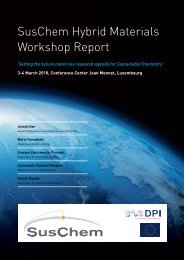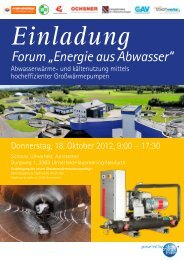GEothErmal DIStrICt hEatING - EGEC
GEothErmal DIStrICt hEatING - EGEC
GEothErmal DIStrICt hEatING - EGEC
Create successful ePaper yourself
Turn your PDF publications into a flip-book with our unique Google optimized e-Paper software.
Reykjavik todaygeothermaldistrict heatingLocation of ParisBasin geothermaldistrict heatingdoubletsChaudes-Aigues, PARspring(exploited since1330 AD)BackgroundDistrict heating – DH – is a system which distributesheat from a centralised generationplant to end (residential, tertiary, commercial,recreational facilities…) users, connected via a heatinggrid and substations. DH has replaced, in mostinstances, traditional central heating systems whereeach building is heated by an individual boiler.Clearly, DH achieves higher energy, economic andenvironmental performance. Heat supply is bestadjusted to users demand. Individual building boilersare replaced by a heat exchanger three wayvalve piping outfit, fuel supplies and operation/maintenanceare optimised, all factors resulting in significantcost savings. Last but not least, it reducesgreenhouse gas emissions and excess heat losses,thus securing upgraded environmental control.As of early 2000’s European DH market penetrationstands as follows (percentage of district heatedhouses) : Iceland: 96%; Baltic States / Poland/ Sweden / Denmark / Finland: 50-60%; Austria /Germany: 12-15%; UK/Netherlands: 1-4%.This record reflects (i) the fact that Iceland enjoysabundant geothermal resources added to a consistentenergy policy of the state in favour of energysavings and renewable energy sources (RES), thelatter adopted by Scandinavian, Baltic and Polishstates, and (ii) an almost negligible DH share in theUK and Netherlands, most likely attributed to an adversenatural gas lobby competition and, at a lesserextent, to milder climatic conditions.Despite its “modernity” DH is nothing new. As amatter of fact, it dates back to Roman ages as witnessedby remnants evidencing city homes andbaths heated via natural hot water catchments andpiping. At Chaudes Aigues, in Central France, a cityDH system, pioneered in year 1330, fed by the Parhot spring at 82°C, is still operating to date. Heatedhomes were charged, in those times, a tax by thelocal landlord in exchange of maintenance duties,as reported in the city annals.Noteworthy is that these early DH systems could becompleted thanks to local hot springs and shallowwells, i.e. (sub)surface evidence of geothermal heatconveyed by water.So, everything considered, engineering of geothermaldistrict heating – GDH – ambitions nothing more thanrevisiting DH sources. However, no way does this “revival”imply a geothermal archaeological itinerary, buta thorough technological accomplishment instead.StatusGDH represents 35% of the European installedpower dedicated to direct uses, i.e.an online capacity nearing 5,000 MWt.Major GDH sites (over 35 exceeding 5 MWt capacity)highlight the dominant role played by Icelandand Turkey, two countries enjoying favourable,volcanically and tectonically active, geodynamicsettings on the Mid Atlantic Ridge and the Aegeanfaçade/Anatolian plateau respectively, demonstratingalso relevant entrepreneurial skills. The twolargest schemes address the heating of the city ofReykjavik and of the Paris suburban area.GDH provides almost the whole of the Reykjavikdemand with an installed capacity of 830 MWtserving 180,000 people, 60 million m 3 /yr of waterat an average 75°C (user inlet) temperature. Thecity grid elsewhere exhibits several distinctive featurescompared to most of its European replica. Animportant part of the hot water supply is piped fromdistant wells and there is no injection whatsoever ofthe heat depleted water (ca 35°C) underground.The Paris Basin GDH system is based on a dependablesedimentary resource environment andon the doublet concept of heat extraction. Here,hot waters at an average 70°C temperature arehosted in permeable carbonate rocks (the Doggerlimestone reservoir) at depths of 1500 to 1800 m.The geothermal fluid, a hot saline brine includinga solution gas phase, is pumped to surface froma production well and the heat depleted brinepumped back into the source reservoir via an injectionwell; the doublet well spacing is designed inorder to avoid premature cooling of the productionwell.












